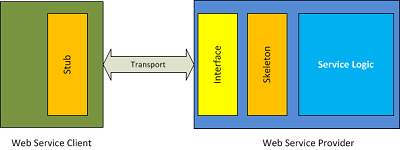Java Web Service Stub Example
Web Service Introduction Tutorial
Last modified on September 12th, 2014 by Joe.
Web service is a system that enables applications to communicate with an API. Web service helps to expose business logic through an API interface where different systems communicate over network. At higher level there are two parties involved, party providing the service is web service provider and the one utilizing it is web service consumer. In a previous hello world tutorial for web service we discussed about creating a service based on soap using Netbeans. This micro tutorial will help understand some important jargon related to web services. In near future we will see tutorials based on Eclipse to create web services.

Generally,
- Application to application communication.
- Interoperability between disparate systems.
- Communication over network.
- Exposed interface is platform independent and internal implementation is abstracted.
- Enables loosely coupled design.
- Open protocol is used for establishing communication.
- Web services are self contained.
Components of a Web Service
This is to highlight some of the important jargons related to web services.
wsdl
Web Services Description Language (WSDL) is used to describe a web service in an XML file. It covers all the aspects of a web service like what is the message format, communication protocol, endpoint, security etc. This is a standard provided by W3C consortium and widely accepted for web services description.
A wsdl xml file for a web service is generally expected to be published publicly so that parties seeking to utilize its services can understand the nature of service and consume it accordingly.
Types
Types is an important element in WSDL. It is used to describe the message attributes and respective types. XSD is the preferred format to describe the types. Type definition can be given in a separate XSD file and imported in WSDL.
<definitions .... > <types> <xsd:schema .... />* </types> </definitions>
UDDI
Universal Description, Discovery and Integration (UDDI) is a directory service. Web services can register with a UDDI and make themselves available through it for discovery. It is like a marriage broker :-) People ready to get married will describe themselves in a standard format (WSDL) and register with this directory. People seeking pair will approach this directory and discover based on the information provided and approach.
Stub and Skeleton
Stub and skeleton are counterparts in a web service setup. Skeleton belongs to service provider side and stub belongs to receiver side. At lower level stub and skeleton communicate with each other. From client side the business objects communicates with stub objects and stub takes the responsibility form the message and invoke the web service. Once the invoking is done, at service provider side, skeleton is the parallel object for stub and it receives the request message and understands it and passes on the information to service side business objects.
Endpoint
An endpoint is a particular network location with associated protocol which includes message format mapping using which we can access that instance of web service. This is described in WSDL file. Consider this as a handle using which we will access the web service.
Binding
Associating an interface with a protocol and message format is binding. It is used in endpoint definition. Binding is described in WSDL.
Operation
A single logical grouping of a meaningful action which comprises a request and response is an operation. Group of operations forms a web service.
SOAP
Simple Object Access Protocol is a XML based specification for web services message format and communication over network. That is it helps to describe the transport method and message format in a web service.
Message
Data that is used to communicate to and fro with a web service is a message. It is a standalone entity which comprises of complete information for a request or a response.
Web Service Design
As given in diagram a web service has logic and an interface. Logic is the actual service provided and interface is used to communicate with the web service. Interface definition is given in WSDL. There are two approaches in implementing a web service and they are bottom-up and top-down.
Bottom Up Approach
Bottom up approach is where we first define the logic of a web service and then using that we will build the interface. Service code is written first and then the WSDL is created using the service code. There are tools available to generate the wsdl file automatically based on it.
Top Down Approach
Top down is the reverse of bottom up approach. First the service definition is written up. WSDL is created first. The complete service definition, message format, transport protocol, security and everything is described in WSDL. Then service is written after the WSDL. Using that wsdl the skeleton code is generated automatically and after that the service code is filled up.
Source: https://javapapers.com/web-service/web-service-introduction-tutorial/
0 Response to "Java Web Service Stub Example"
Post a Comment